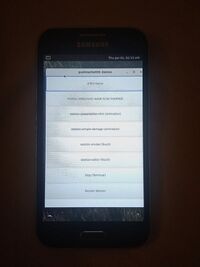Samsung Galaxy Core Prime VE LTE (samsung-coreprimevelte)
| This is one specific Galaxy Core Prime hardware revision. For an overview, see Samsung Galaxy Core Prime |
 | |
| Manufacturer | Samsung |
|---|---|
| Name | Galaxy Core Prime VE LTE |
| Codename | samsung-coreprimevelte |
| Released | 2014 |
| Type | handset |
| Hardware | |
| Chipset | Marvell PXA1908 |
| CPU | 4x 1.2 GHz Cortex-A53 |
| GPU | Vivante GC7000UL |
| Display | 480x800 |
| Storage | 8 GB |
| Memory | 1 GB |
| Architecture | aarch64 |
| Software | |
Original software The software and version the device was shipped with. |
Android (TouchWiz) 5.1.1 |
Extended version The most recent supported version from the manufacturer. |
Android (TouchWiz) |
| FOSS bootloader | yes |
| postmarketOS | |
| Category | community |
Pre-built images Whether pre-built images are available from the postmarketOS Installation page. |
yes |
Mainline Instead of a Linux kernel fork, it is possible to run (Close to) Mainline. |
yes |
pmOS kernel The kernel version that runs on the device's port. |
6.14.0 |
Unixbench score Unixbench Whetstone/Dhrystone score. See Unixbench. |
0.0 |
| Device package |
|
| Kernel package |
|
Flashing Whether it is possible to flash the device with pmbootstrap flasher. |
Works
|
|---|---|
USB Networking After connecting the device with USB to your PC, you can connect to it via telnet (initramfs) or SSH (booted system). |
Works
|
Internal storage eMMC, SD cards, UFS... |
Works
|
SD card Also includes other external storage cards. |
Works
|
Battery Whether charging and battery level reporting work. |
Broken
|
Screen Whether the display works; ideally with sleep mode and brightness control. |
Partial
|
Touchscreen |
Works
|
| Multimedia | |
3D Acceleration |
Broken
|
Audio Audio playback, microphone, headset and buttons. |
Broken
|
Camera |
Broken
|
Camera Flash |
Broken
|
| Connectivity | |
WiFi |
Partial
|
Bluetooth |
Partial
|
GPS |
Broken
|
NFC Near Field Communication |
Broken
|
| Modem | |
Calls |
Broken
|
SMS |
Broken
|
Mobile data |
Broken
|
| Miscellaneous | |
FDE Full disk encryption and unlocking with unl0kr. |
Works
|
USB OTG USB On-The-Go or USB-C Role switching. |
Broken
|
| Sensors | |
Accelerometer Handles automatic screen rotation in many interfaces. |
Broken
|
Proximity |
Broken
|
Haptics |
Works
|
| This device is based on the Marvell PXA1908. See the SoC page for common tips, guides and troubleshooting steps |
Users owning this device
- AAT596 (Notes: (1+) Original Android, trying to build a custom ROM for them because there's none as of now)
- CoderCharmander
- LegoLivesMatter (Notes: Currently mainlining)
- RobusTetus
- StandaSK
- Stupidenbyace
Installation
After unlocking the bootloader (simply enable developer options and enable OEM unlocking), refer to Installation/Using a pre-built image or Installation/Using pmbootstrap and #Flashing.
Using Heimdall, flash boot.img onto KERNEL and the other image onto either SYSTEM or USER, though it's highly recommended to install to USER as it has much more space than SYSTEM (~5.2GB versus ~1.8GB).
Pre-built Sxmo images are available here: edge (recommended), v25.06.
If you wish to use the downstream port for whatever reason, you can do so by choosing coreprimevelte-downstream as the device.
Mainline
As of pmaports!4540 mainline is used by default when selecting the device in pmbootstrap. So far, there's only a DTS for rev02 (out of rev00 and rev01), but the rest seem to be identical with the difference that one pin is in a different pinctrl group.
Flashing
The device can be put in flashing mode by powering it on while pressing the POWER + HOME + VOLUME DOWN buttons simultaneously, and answering the appearing question by pressing VOLUME UP.
Flashing via recovery zip works.
UART
UART over the microUSB connector can be enabled by putting a 150k or 619k resistor between the ID and GND pins. The device TX will be on the D- pin, and RX will be on the D+ pin. A 619k will power on the device as soon as the UART cable is connected, while a 150K won't.
Signal level is 1.8V, although I had once connected it to 3.3V and it doesn't seem to have damaged the phone nor the UART in any way. It's still recommended to avoid going above 1.8V.
U-Boot
The mainline port uses U-Boot. As of now, it loads the kernel from an initramfs passed to U-Boot by the primary bootloader.
The U-Boot fork can be found here.
See also
- pmaports!1823 Initial merge request
- pmaports!4267 Mainline kernel merge request
 device-samsung-coreprimevelte
device-samsung-coreprimevelte linux-samsung-coreprimevelte
linux-samsung-coreprimevelte device-samsung-coreprimevelte-downstream (downstream)
device-samsung-coreprimevelte-downstream (downstream) linux-samsung-coreprimevelte-downstream (downstream)
linux-samsung-coreprimevelte-downstream (downstream)